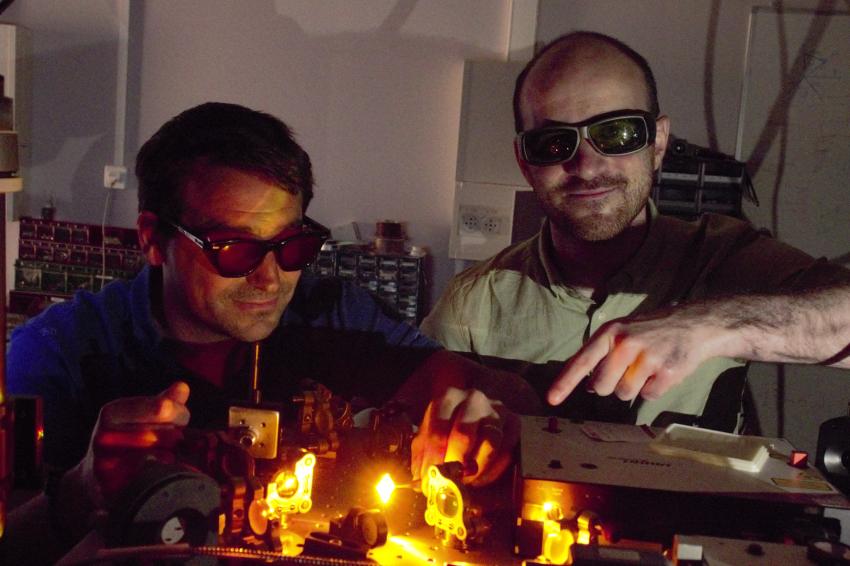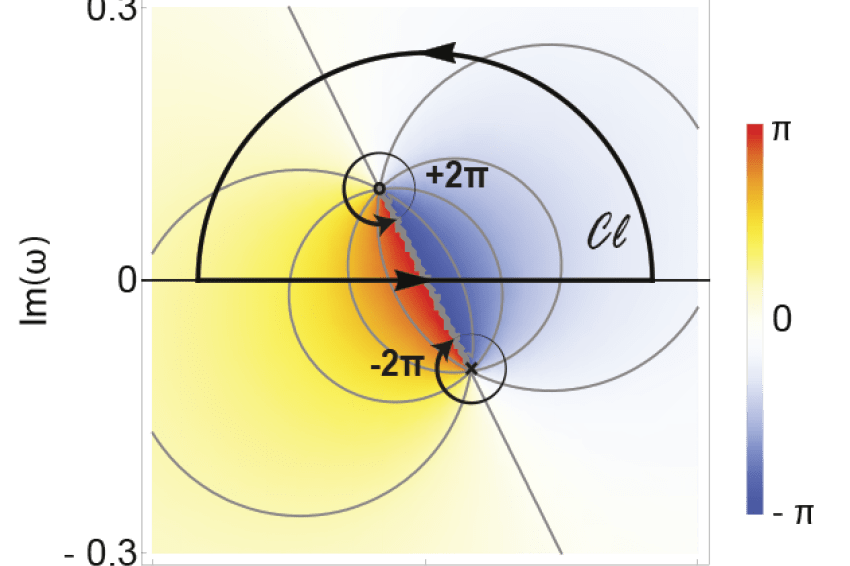Complex is the scattering of light
06.07.2023 - Understanding how nanoparticles influence light rays could provide innovative and more efficient designs of metasurfaces for future optical devices and metaoptical systems.
Researchers at the Université Côte d’Azur in collaboration with the Ecole Polytechnique Fédérale de Lausanne and the Zuse Institute Berlin have unveiled a surprisingly intriguing and captivating effect describing light scattering with resonant nanoparticles. By studying the optical response of nanoparticles excited with light oscillating at complex frequencies, i.e. looking at the reflected or transmitted light across an assembly of nanoparticles excited by a time-varying incident light beam, they demonstrated that the positions of spectral singularities – also dubbed poles and zeros – play a major role in the response of the system. More precisely, they realized that a universal 0 to 2π-phase response, which is needed for the design of photonic components, can be imparted on the output channel whenever a zero and a pole forming a pair of complex singularities are placed in the complex frequency plane on either side of the real axis.
The discontinuity line that connects the two singularities (branch cut in complex analysis) provides a full phase modulation when it crosses the real frequency axis. This understanding explains the physics behind most of the modulation effects observed in resonant optical systems, including the so-called Huygens metasurfaces, and it could offer new design rules for the next generation of optical components for traditional 2D and 3D lidar imaging, wavefront engineering, displays and even future quantum optical components.
“Every single component in photonics is conceived to manipulate or to redirect the light coming from the environment. If you want, we could simply say that photonic components are intrinsically open systems, coupled to their surrounding environment via radiative channels. The presence of lossy channels are total game changer as these systems have to be described using a non-Hermitian theoretical framework,” explains Patrice Genevet, a group leader at CNRS-CRHEA in Valbonne, Côte d’Azur, France. Because of the presence of radiative or absorption losses, interesting effects can occur, including complex eigenvalues topology, eigenvector degeneracy and branch point singularities. Complex zero singularities describing the lack of reflection of transmission appear.
In this article, we brought to the attention of the nanophotonics and meta-optics communities the existence of basic concepts associated with topological photonics. We connect peculiar light scattering phenomena with the presence and the position of complex singularities.
The unidirectional forward and backward scattering mechanisms, previously connected to the so-called Kerker conditions, appear to have their origin deeply rooted in the topological and non-Hermitian physics characterized by the appearance of a spontaneous symmetry breaking condition. This strange behavior occurs upon changes in the nanostructure geometry and after encountering an exceptional point, shown by the superposition of two zero singularities. Spontaneous symmetry-breaking is characterized by the modification of the zero positions, bringing non-zero conjugated imaginary parts, i.e. zeros are symmetrically ejected from the real frequency axis. As a result, the system opens a high transmission window of interest to the design of efficient forward scatter: the perfect Huygens source.
While metasurfaces have already been shown to manipulate the properties of light, such as its polarization, phase, and amplitude, enhancing their efficiency and functionality would open new industrial opportunities. For instance in the field of optics and photonics, improved metasurface performance can revolutionize the design of compact and lightweight optical devices, leading to advancements in imaging systems, augmented reality displays, and high-speed optical communications. Furthermore, in the energy sector, efficient metasurfaces can enhance solar energy harvesting and improve the efficiency of solar cells, thereby promoting renewable energy adoption. Additionally, metasurfaces can enable the development of advanced sensing technologies, such as ultra-sensitive detectors for environmental monitoring and healthcare applications.
Dr Genevet and his co-workers have revealed that the relative positions of complex singularities are the keys to improve the efficiency of metasurfaces and photonic systems in general that are operating in reflection, in transmission or that can convert polarization. This work could enable an entirely new class of unidirectional or asymmetrical photonic device capable of addressing asymmetrically the response of light to different channels. The concepts discussed in this paper extend beyond the nanophotonics community and could have impact in various fields of research including photonic integrated circuits, quantum optics and electronics. (Source: P. Genevet)
Link: METAsurface group at the Université Côte d’Azur, Valbonne France
Reference: Rémi Colom, Elena Mikheeva, Karim Achouri, Jesus Zuniga-Perez, Nicolas Bonod, Olivier J. F. Martin, Sven Burger, Patrice Genevet: Crossing of the Branch Cut: The Topological Origin of a Universal 2π-Phase Retardation in Non-Hermitian Metasurfaces, Laser Phot. Rev. 17(6), June 2023; DOI: 10.1002/lpor.202200976







